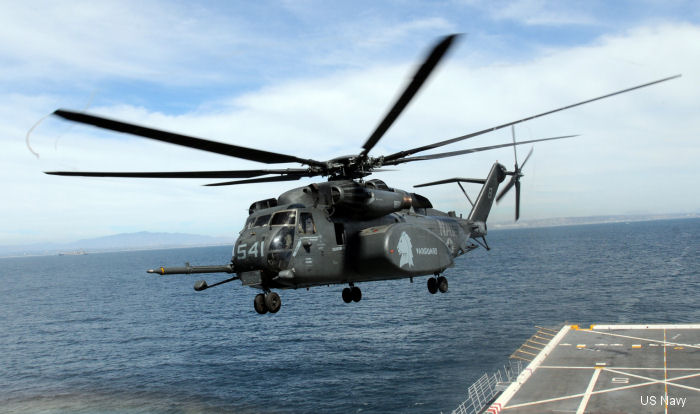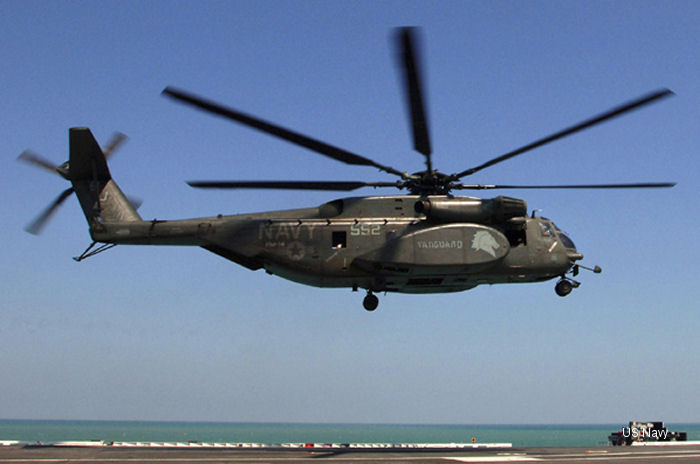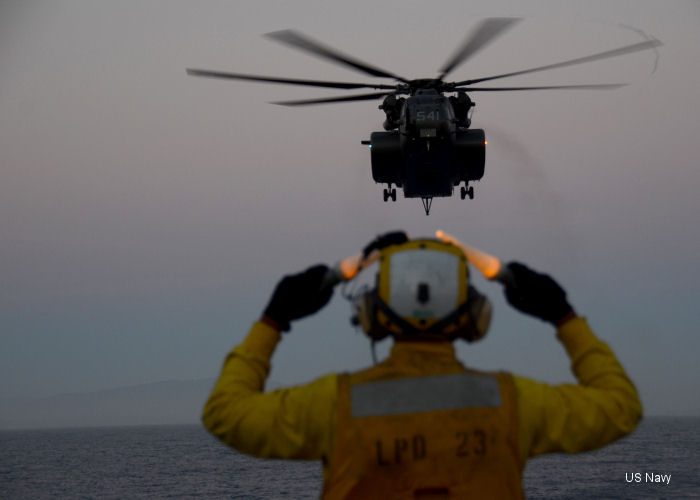US Navy, July 27, 2014 - AT SEA By Chief Mass Communication Specialist (SW/AW) Elena Pence USS Anchorage - Helicopter Mine Countermeasures Squadron 14 (HM-14) conducted airborne mine countermeasures (AMCM) training aboard amphibious transport dock USS Anchorage (LPD 23) as part of Rim of the Pacific (RIMPAC) Exercise 2014.
AMCM was one of Anchorage's missions during RIMPAC, completing nearly 300 hours of flight time.
"HM-14's participation in RIMPAC is essential and beneficial for many reasons," said Lt. Cmdr. Daniel Grover, officer in charge for HM-14.
"It allows the squadron to execute cross-country flights, conduct shipboard operations, integrate with the International Mine Countermeasures Staff (MCM) Combined Task Force (CTF) 177.1, and participate as part of the MCM Triad to meet squadron unit level training goals, execute AMCM mission tasking, and remind the larger Navy as a whole what the HM community and the MH-53E Sea Dragon is capable of accomplishing."
HM-14's primary mission is AMCM, which is the ability to detect, classify, and prosecute mines. With their MH-53E Sea Dragon helicopter, the squadron can tow a variety of devices designed to neutralize mines. They have the ability to mechanically sweep and cut moored mines or actuate mines by influence. The devices can be configured to mimic a ship's signature.
"One of the devices we tow is called the Mk-104. The Mk-104 can be adjusted to mimic a ship's acoustic signature via its adjustable propeller. We tune it differently depending on what mine we are trying to prosecute," said Lt. Chad Peterson, a HM-14 pilot from Tampa, Fla.
"Some mines will only actuate when specific criteria is met. Should an aircraft carrier or destroyer need to pass through a mine field, we can tune the Mk-104 to produce the same acoustic signature as the specific ship's propellers. We would be able to clear those mines before the ship arrives in the area. Another device we tow has sonar and allows us to map the bathymetry of the ocean floor. It gives us the ability to locate moored mines, close-tethered mines, and bottom-laying mines, as well. This device also features a laser so we can positively identify what we have detected and can prosecute the mine accordingly."
For HM-14's missions, divers would place mine replicas in the ocean for the squadron to locate using their devices and simulate the steps to divest them.
"Our explosive ordnance disposal (EOD) counterparts have dropped off mine shapes for us to practice on. This isn't something we're able to do back home. We have actual mine shapes and cases to practice on here at RIMPAC. This has been a tremendous opportunity for our aircrew and minemen to learn from," Peterson said. "With the missions we've been able to complete so far, we have been pretty successful. Our Sailors have been working nonstop and the results are very apparent. There are a lot of things going on behind the scenes to make these missions possible and we wouldn't have been nearly as successful if it weren't for the hard work and motivation from our Sailors."
HM-14, home ported at Naval Station Norfolk, Va., has recently gained nearly 20 new flight crew members. Most of the squadron's experience has only been on a flight line and before training began, the squadron had to recertify their flight deck qualifications.
"This particular RIMPAC has allowed HM-14 to fly almost 300 flight hours in less than 40 days, something that has not happened in quite a long time at the squadron," Grover said. "Additionally, we increased pilot and aircrew qualifications by over 50 percent, while still completing all volume and bottom search AMCM tasking. The experiences gained in RIMPAC 2014 will pay dividends to the squadron for years to come."
RIMPAC offers both HM-14 and Anchorage Sailors the opportunity to work with operations unique to a LPD platform and to the HM-14 squadron. LPDs are not known to carry helicopters as large as the MH-53E Sea Dragon, and HM-14 hasn't operated from a ship's flight deck in nearly eight years.
"We have never dealt with [MH-53E] helos or the mine-sweeping countermeasure missions the aircraft has been doing for RIMPAC," said Lt. Cmdr. Brian Bradach, Anchorage's air boss. "It has been challenging, but because of RIMPAC, Anchorage Sailors are gaining experiences they may have never gotten on board. This is a unique opportunity and it only makes us better."
HM-14 arrived two weeks before they departed for RIMPAC on Anchorage. They had to quickly integrate with the ship and Sailors on board to accomplish missions they were tasked with from CTF 177.1.
"The thing I've learned the most is communication is key," said Aviation Electrician's Mate 2nd Class (AW) Daniel Naquin. "If anyone in the wing or on the ship drops communication then there's going to be a break in the mission or task at hand. Everyone is having a learning experience; we are not only training the ship, but we are also receiving good training."
"The Anchorage Sailors have been really accommodating and very welcoming," said Aviation Structural Mechanic 1st Class (AW/SW) Christopher Goodloe. "We are at flight quarters for most of the day and would miss lunch or dinner, but the Sailors on the Anchorage made sure everyone of us had hot plates. If we were lost or even looked lost,
[Anchorage Sailors] would ask if we needed help getting anywhere and would even stop what they were doing to escort us."
Twenty-two nations, 49 ships, six submarines, more than 200 aircraft and 25,000 personnel are participating in RIMPAC from June 26 - Aug. 1, in and around the Hawaiian Islands and Southern California. The world's largest international maritime exercise, RIMPAC provides a unique training opportunity that helps participants foster and sustain the cooperative relationships that are critical to ensuring the safety of sea lanes and security on the world's oceans. RIMPAC 2014 is the 24th exercise in the series that began in 1971.
Anchorage was built at the Huntington Ingalls Shipbuilding site in Avondale, Louisiana and is the seventh San Antonio-class amphibious transport dock ship. Delivered to the U.S. Navy on Sept. 17, 2012, the ship was commissioned on May 4, 2013 in the namesake city of Anchorage, Alaska.
AMCM was one of Anchorage's missions during RIMPAC, completing nearly 300 hours of flight time.
"HM-14's participation in RIMPAC is essential and beneficial for many reasons," said Lt. Cmdr. Daniel Grover, officer in charge for HM-14.
"It allows the squadron to execute cross-country flights, conduct shipboard operations, integrate with the International Mine Countermeasures Staff (MCM) Combined Task Force (CTF) 177.1, and participate as part of the MCM Triad to meet squadron unit level training goals, execute AMCM mission tasking, and remind the larger Navy as a whole what the HM community and the MH-53E Sea Dragon is capable of accomplishing."
HM-14's primary mission is AMCM, which is the ability to detect, classify, and prosecute mines. With their MH-53E Sea Dragon helicopter, the squadron can tow a variety of devices designed to neutralize mines. They have the ability to mechanically sweep and cut moored mines or actuate mines by influence. The devices can be configured to mimic a ship's signature.
"One of the devices we tow is called the Mk-104. The Mk-104 can be adjusted to mimic a ship's acoustic signature via its adjustable propeller. We tune it differently depending on what mine we are trying to prosecute," said Lt. Chad Peterson, a HM-14 pilot from Tampa, Fla.
"Some mines will only actuate when specific criteria is met. Should an aircraft carrier or destroyer need to pass through a mine field, we can tune the Mk-104 to produce the same acoustic signature as the specific ship's propellers. We would be able to clear those mines before the ship arrives in the area. Another device we tow has sonar and allows us to map the bathymetry of the ocean floor. It gives us the ability to locate moored mines, close-tethered mines, and bottom-laying mines, as well. This device also features a laser so we can positively identify what we have detected and can prosecute the mine accordingly."
For HM-14's missions, divers would place mine replicas in the ocean for the squadron to locate using their devices and simulate the steps to divest them.
"Our explosive ordnance disposal (EOD) counterparts have dropped off mine shapes for us to practice on. This isn't something we're able to do back home. We have actual mine shapes and cases to practice on here at RIMPAC. This has been a tremendous opportunity for our aircrew and minemen to learn from," Peterson said. "With the missions we've been able to complete so far, we have been pretty successful. Our Sailors have been working nonstop and the results are very apparent. There are a lot of things going on behind the scenes to make these missions possible and we wouldn't have been nearly as successful if it weren't for the hard work and motivation from our Sailors."
HM-14, home ported at Naval Station Norfolk, Va., has recently gained nearly 20 new flight crew members. Most of the squadron's experience has only been on a flight line and before training began, the squadron had to recertify their flight deck qualifications.
"This particular RIMPAC has allowed HM-14 to fly almost 300 flight hours in less than 40 days, something that has not happened in quite a long time at the squadron," Grover said. "Additionally, we increased pilot and aircrew qualifications by over 50 percent, while still completing all volume and bottom search AMCM tasking. The experiences gained in RIMPAC 2014 will pay dividends to the squadron for years to come."
RIMPAC offers both HM-14 and Anchorage Sailors the opportunity to work with operations unique to a LPD platform and to the HM-14 squadron. LPDs are not known to carry helicopters as large as the MH-53E Sea Dragon, and HM-14 hasn't operated from a ship's flight deck in nearly eight years.
"We have never dealt with [MH-53E] helos or the mine-sweeping countermeasure missions the aircraft has been doing for RIMPAC," said Lt. Cmdr. Brian Bradach, Anchorage's air boss. "It has been challenging, but because of RIMPAC, Anchorage Sailors are gaining experiences they may have never gotten on board. This is a unique opportunity and it only makes us better."
HM-14 arrived two weeks before they departed for RIMPAC on Anchorage. They had to quickly integrate with the ship and Sailors on board to accomplish missions they were tasked with from CTF 177.1.
"The thing I've learned the most is communication is key," said Aviation Electrician's Mate 2nd Class (AW) Daniel Naquin. "If anyone in the wing or on the ship drops communication then there's going to be a break in the mission or task at hand. Everyone is having a learning experience; we are not only training the ship, but we are also receiving good training."
"The Anchorage Sailors have been really accommodating and very welcoming," said Aviation Structural Mechanic 1st Class (AW/SW) Christopher Goodloe. "We are at flight quarters for most of the day and would miss lunch or dinner, but the Sailors on the Anchorage made sure everyone of us had hot plates. If we were lost or even looked lost,
[Anchorage Sailors] would ask if we needed help getting anywhere and would even stop what they were doing to escort us."
Twenty-two nations, 49 ships, six submarines, more than 200 aircraft and 25,000 personnel are participating in RIMPAC from June 26 - Aug. 1, in and around the Hawaiian Islands and Southern California. The world's largest international maritime exercise, RIMPAC provides a unique training opportunity that helps participants foster and sustain the cooperative relationships that are critical to ensuring the safety of sea lanes and security on the world's oceans. RIMPAC 2014 is the 24th exercise in the series that began in 1971.
Anchorage was built at the Huntington Ingalls Shipbuilding site in Avondale, Louisiana and is the seventh San Antonio-class amphibious transport dock ship. Delivered to the U.S. Navy on Sept. 17, 2012, the ship was commissioned on May 4, 2013 in the namesake city of Anchorage, Alaska.
See also |
HM-14







